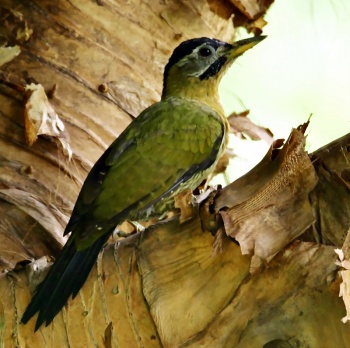- Picus vittatus
Identification
30 - 33 cm (11¾-13 in)
- Red forehead to crown and short crest, bordered by thin black line
- Narrow white eyering and short supercilium
- Pale greyish to buffish ear-coverts, faintly streaked brown
- Black malar stripe with some white streaks or spots
- Plain whitish-buff to pale yellow-green or yellow chin and throat
- Yellow-green upperparts, more yellowish on rump
- Bronze-green wings with blackish-brown flight-feathers
- Blackish uppertail with some thin pale bars on outer feathers
- Buffish-yellow or olive-buff breast, lower breast with scaly pattern
- Longish, broad-based, blackish bill with curved culmen, lower mandible dull yellow
Females are shorter-billed and have a black forehead and nape.
Juveniles are duller with more diffuse underparts markings.
Similar species
Paler throat, yellow breast, more prominent black malar stripe and less bronzy upperparts separate this species from Streak-breasted Woodpecker.
Distribution
From southeast Asia (eastern Myanmar to Thailand, Vietnam, Laos and Cambodia) to peninsular Malaysia, Singapore, Sumatra, Java and Bali.
Locally common.
Taxonomy
This is a monotypic species.
Habitat
Found in deciduous forest, evergreen forest, secondary growth, bamboo and gardnes. Also in open coastal forest and scrub, including casuarinas and coconut plantations. Mainly in mangroves where ranges overlaps with Streak-breasted Woodpecker in western and southwestern Thailand. Occurs from sea-level up to 200 m in Greater Sundas, up to 1500 m in southeast Asia.
Behaviour
Diet
Feeds on beetles and flies.
Usually in pairs or singly, pairs keeping in close contact. Forages on the ground as well as in trees.
Breeding
Breeding season from February to July, breeding recorded in January, April and September in Java. The nest-hole is excavated at 0.5 to 9 m in a tree. Lays 3 to 4 eggs.
Movements
This is a resident species.
References
- Clements, J. F., T. S. Schulenberg, M. J. Iliff, D. Roberson, T. A. Fredericks, B. L. Sullivan, and C. L. Wood. 2017. The eBird/Clements checklist of birds of the world: v2017, with updates to August 2017. Downloaded from http://www.birds.cornell.edu/clementschecklist/download/
- Handbook of the Birds of the World Alive (retrieved August 2016)
Recommended Citation
- BirdForum Opus contributors. (2024) Laced Woodpecker. In: BirdForum, the forum for wild birds and birding. Retrieved 25 April 2024 from https://www.birdforum.net/opus/Laced_Woodpecker





